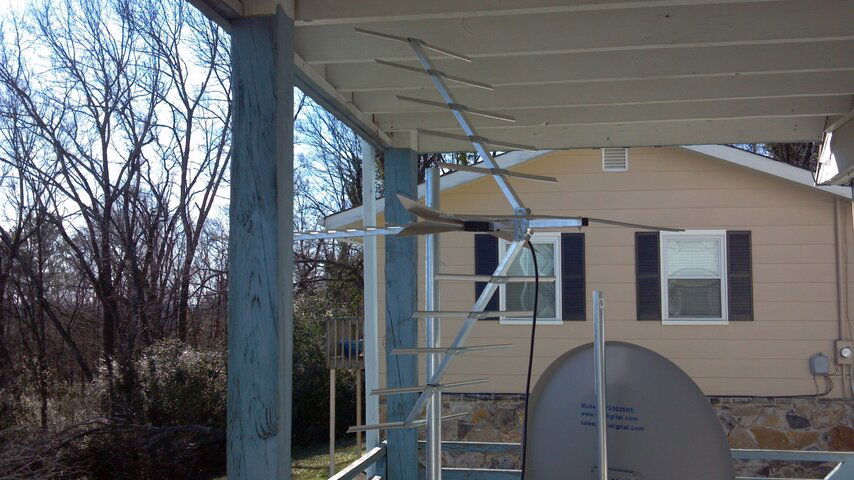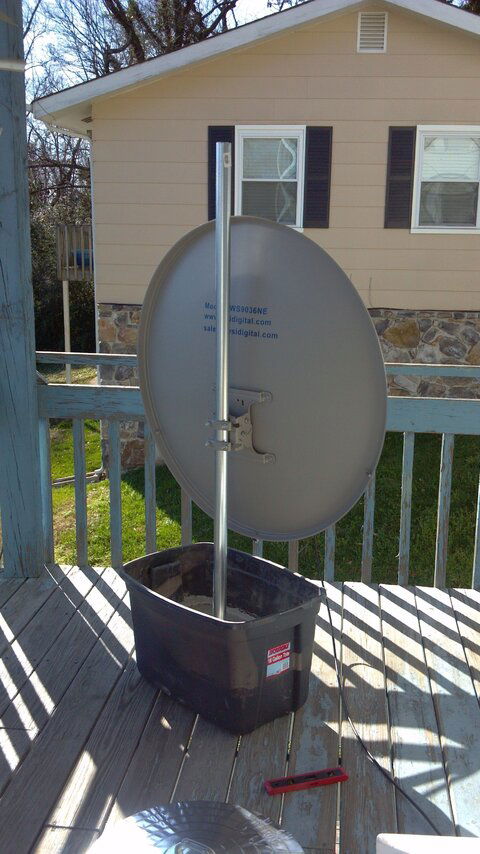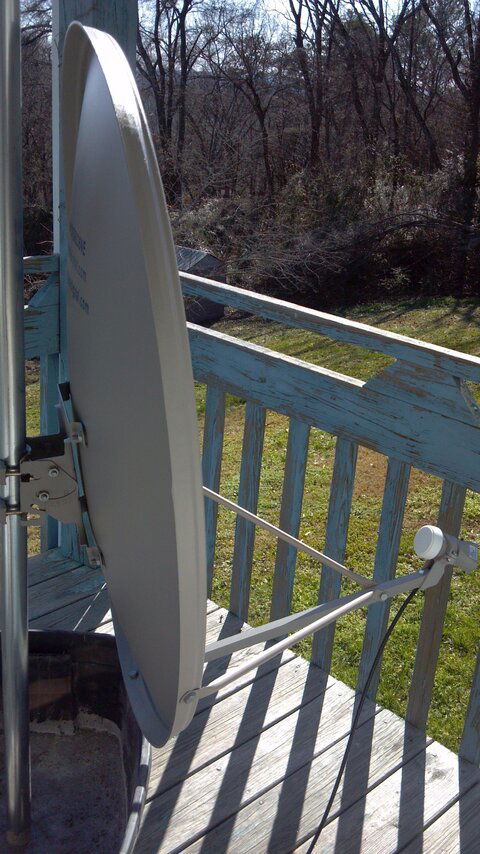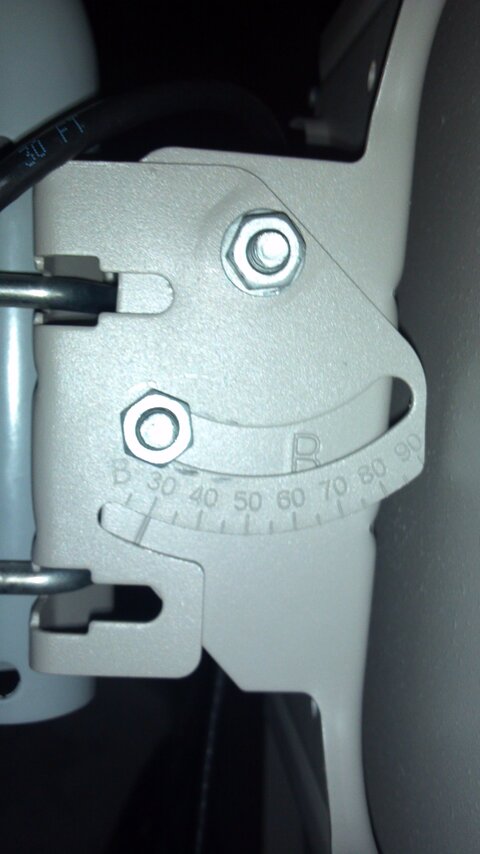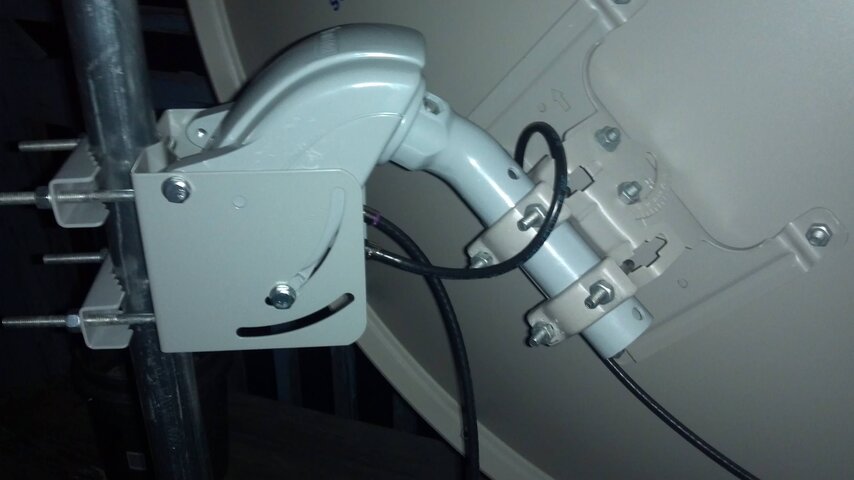Hello, all:
For those who do not already know, I began working at Luken Communications two months ago (November 14), and details can be found here. The Big Announcement - RabbitEars Blog As a result, I now live in Chattanooga, Tennessee near the top of a mountain, which makes me happy as I always wanted to live on the top of a mountain.
Anyway, a friend of mine from Wisconsin with whom I attended UVA came down to visit around New Year's to go to the UVA sportball game in Atlanta. He is the person who got me into FTA in the first place, so between his visit and the recent endless pledge drives on both local PBS stations, I decided I needed a motorized FTA setup here in addition to the one I left at home. I had brought my receivers and LNBF down with me, but the dish and pole would not fit. The day before his arrival, I drove down to Galaxy Marketing in Atlanta and picked up the "Economy Pack" that they offer. It features a 9120 motor and 90cm dish, plus an LNBF that I have yet to open.
On Saturday morning before the game, we went over to Lowes and got appropriate containers, poles, and Quikrete to create a pole for my antenna and a pole for my dish. Everything was poured, checked, and leveled, then left to set while we went to the game that evening. On Sunday, we went to assemble the motor and discovered that the bracket was folded in the wrong place, resulting in the holes being very out of alignment. A call down to Atlanta later in the week and an e-mail of a picture got me a free bracket, but my friend had to leave on Monday morning, so he carefully aimed the dish at 125W for me and it has turned out to be very reliable. I've attached several photos of this setup.
My replacement bracket came early this week and today I went ahead and installed it today. I checked that the pole was level after I attached the motor and dish, and after adding two shims it seems pretty close, but I'm having the exact same issue with it that I had in Virginia, which is that 125W wants the dish pulled back, while 97W wants the dish pushed forward, and I cannot find a good compromise position. I eventually just peaked 125W and came inside because I was getting cold, but at some point I will have to tinker with it some more. I know my Virginia setup needed to be rotated west a few degrees to clean it up, so I may have to give that a try.
While I was out playing with it, I went as far east as to get the Luken mux on 83W (needed to test that a dish of that size would pick it up) and as far west as 127W, albeit not without tweaking, and so far it looks like I have a good line of sight. I need to see just how far east my line of sight will go, though I am looking to the east off my deck, so I am imagining 30W should be doable.
One other thing, I was trying to aim at 85W (my due south sat) but couldn't find any signal on the mux listed as "strong" in the "strong transponder" thread here. Anyone seeing it? 85 (AMC16 formerly AMC2)-12195 H 3978
Any thoughts or opinions for me?
- Trip
For those who do not already know, I began working at Luken Communications two months ago (November 14), and details can be found here. The Big Announcement - RabbitEars Blog As a result, I now live in Chattanooga, Tennessee near the top of a mountain, which makes me happy as I always wanted to live on the top of a mountain.
Anyway, a friend of mine from Wisconsin with whom I attended UVA came down to visit around New Year's to go to the UVA sportball game in Atlanta. He is the person who got me into FTA in the first place, so between his visit and the recent endless pledge drives on both local PBS stations, I decided I needed a motorized FTA setup here in addition to the one I left at home. I had brought my receivers and LNBF down with me, but the dish and pole would not fit. The day before his arrival, I drove down to Galaxy Marketing in Atlanta and picked up the "Economy Pack" that they offer. It features a 9120 motor and 90cm dish, plus an LNBF that I have yet to open.
On Saturday morning before the game, we went over to Lowes and got appropriate containers, poles, and Quikrete to create a pole for my antenna and a pole for my dish. Everything was poured, checked, and leveled, then left to set while we went to the game that evening. On Sunday, we went to assemble the motor and discovered that the bracket was folded in the wrong place, resulting in the holes being very out of alignment. A call down to Atlanta later in the week and an e-mail of a picture got me a free bracket, but my friend had to leave on Monday morning, so he carefully aimed the dish at 125W for me and it has turned out to be very reliable. I've attached several photos of this setup.
My replacement bracket came early this week and today I went ahead and installed it today. I checked that the pole was level after I attached the motor and dish, and after adding two shims it seems pretty close, but I'm having the exact same issue with it that I had in Virginia, which is that 125W wants the dish pulled back, while 97W wants the dish pushed forward, and I cannot find a good compromise position. I eventually just peaked 125W and came inside because I was getting cold, but at some point I will have to tinker with it some more. I know my Virginia setup needed to be rotated west a few degrees to clean it up, so I may have to give that a try.
While I was out playing with it, I went as far east as to get the Luken mux on 83W (needed to test that a dish of that size would pick it up) and as far west as 127W, albeit not without tweaking, and so far it looks like I have a good line of sight. I need to see just how far east my line of sight will go, though I am looking to the east off my deck, so I am imagining 30W should be doable.
One other thing, I was trying to aim at 85W (my due south sat) but couldn't find any signal on the mux listed as "strong" in the "strong transponder" thread here. Anyone seeing it? 85 (AMC16 formerly AMC2)-12195 H 3978
Any thoughts or opinions for me?
- Trip
Attachments
Last edited:


